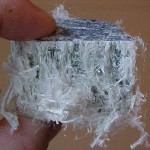 The National Institute of Standards and Technology (NIST) has issued what is being touted as the world’s first reference material for single-wall carbon nanotube soot. In its statement, NIST calls single-wall carbon nanotubes (SWCNT) “perhaps the archetype of all nanoscale materials.” The promise of SWCNT in industrial use is great (NIST chemical engineer Jeffrey Fagan stated that “full development of these materials should enable lighter, stronger materials, as well as improve many technologies from sensors to electronics and batteries”). But as with most things, there’s a catch.
The National Institute of Standards and Technology (NIST) has issued what is being touted as the world’s first reference material for single-wall carbon nanotube soot. In its statement, NIST calls single-wall carbon nanotubes (SWCNT) “perhaps the archetype of all nanoscale materials.” The promise of SWCNT in industrial use is great (NIST chemical engineer Jeffrey Fagan stated that “full development of these materials should enable lighter, stronger materials, as well as improve many technologies from sensors to electronics and batteries”). But as with most things, there’s a catch.
Production of SWCNT involves a complex process that is known for inconsistent quality, variability from batch to batch, and significant resulting impurities. NIST has sought to provide the first standardized guidelines – both chemical and metric – to the production of nanotubes, through the publication of its Standard Reference Material SRM 2483 – Single-Wall Carbon Nanotubes (Raw Soot) on December 20, 2011. The purpose of the SRM is to provide industrial developers and producers with a means to evaluate chemical and instrumental methods of analysis of carbon nanotubes with the goal of improving quality and consistency across the board.
Of special interest to me is the Material Safety Data Sheet (MSDS) for SWCNT raw soot, which was simultaneously issued by NIST. The MSDS reveals that little is known about the potential hazards of this substance in the workplace setting. The MSDS contains the following statement regarding single-wall carbon nanotubes raw soot:
“According to NIOSH, currently there are no studies reported in the literature of adverse health effects in workers producing or using carbon nanotubes or carbon nanofibers. The concern about worker exposure to these materials arises from results of animal studies. Several studies in rodents have shown an equal or greater potency of carbon nanotubes compared to other inhaled particles known to be hazardous to exposed workers (ultrafine carbon black, crystalline silica, and asbestos) in causing adverse lung effects including pulmonary inflammation and fibrosis.”
Did the word “asbestos” jump off the page? And just because this substance is not listed as a potential carcinogen in the National Toxicology Program (NTP) Report on Carcinogens, the International Agency for Research on Cancer (IARC) Monographs, or by OSHA does not mean that it doesn’t pose a significant health risk to workers. Pulmonary fibrosis, in the form of asbestosis and silicosis, has been a major public health problem for decades and a legal problem of immeasurable proportions.
Furthermore, the MSDS states, under Toxicology Information, that “[a]nimal in vitro cell studies have shown that SWCNT can cause genotoxicity and abnormal chromosome number due to interference with mitosis.” But the research has not yet demonstrated any effects in the animals other than the observed impact, perhaps because the technology is so new and the research in its infancy.
Under Ecotoxicity Data, the MSDS states, “No data available.”
Clearly, there is an urgent need for more study of the potential health hazards of SWCNT, both acute and chronic. So while the Standard Reference Material is a giant step toward consistency of standards, the MSDS reveals that it is only a baby step in the larger scheme of things. Much research needs to be done on the impact of these new technologies on workers and ultimately on consumers and the environment.
The NIST statement, with image, is available at
http://www.nist.gov/mml/polymers/cnt-122011.cfm
The Standard Reference Material is available at
https://www-s.nist.gov/srmors/view_detail.cfm?srm=2483
The MSDS, with sources, is available through a link from the Standard Reference Material page immediately above.
 I have written
I have written 